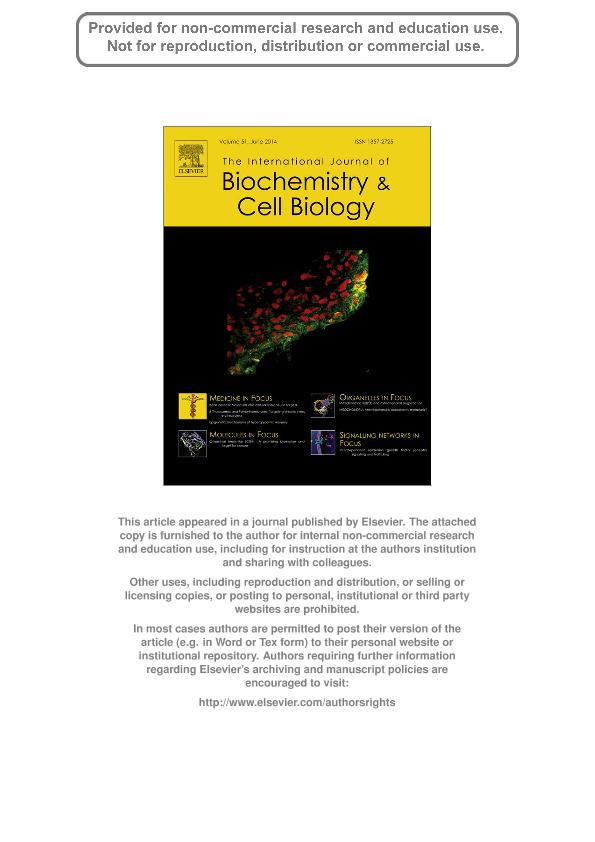Mostrar el registro sencillo del ítem
dc.contributor.author
Porretti, Juliana Carla

dc.contributor.author
Mohamad, Nora A.

dc.contributor.author
Martin, Gabriela Adriana

dc.contributor.author
Cricco, Graciela P.
dc.date.available
2017-05-19T20:52:06Z
dc.date.issued
2014-06
dc.identifier.citation
Porretti, Juliana Carla; Mohamad, Nora A.; Martin, Gabriela Adriana; Cricco, Graciela P.; Fibroblasts induce epithelial to mesenchymal transition in breast tumor cells which is prevented by fibroblasts treatment with histamine in high concentration; Elsevier; International Journal Of Biochemistry And Cellular Biology; 51; 6-2014; 29-38
dc.identifier.issn
1357-2725
dc.identifier.uri
http://hdl.handle.net/11336/16783
dc.description.abstract
Epithelial to mesenchymal transition (EMT) of cancer cells is an essential process in cancer progression. Cancer cells that undergone EMT loose cell–cell contacts, acquire mesenchymal properties and develop migratory and invasive abilities. In previous studies we have demonstrated that histamine may modify the invasive phenotype of pancreatic and mammary tumor cells. In this work we proposed to investigate whether histamine may also influence the interaction between tumor cells and normal fibroblasts. The potential activation of normal CCD-1059Sk fibroblasts by histamine and EMT phenotypic changes induced in MCF-7 and MDA-MB-231 breast tumor cells by the conditioned media (CM) derived from fibroblasts were evaluated. Initially, we determined the presence of H1, H2 and H4 histamine receptors and matrix metalloproteinase 2 (MMP2) mRNA in CCD-1059Sk fibroblasts. MMP2 gelatinolytic activity, cell migration and alpha-smooth muscle actin expression were increased in fibroblasts by low doses (<1 μM) and decreased by high doses (20 μM) of histamine. MCF-7 cells cultured with CM from fibroblasts exhibited spindle-shaped morphology, cell spreading and cytoplasmic expression of β-catenin but there was no change in MMP2 activity and cell migration. MDA-MB-231 cells cultured with CM from fibroblasts showed a more elongated phenotype, cell spreading, cytoplasmic β-catenin, increased MMP2 activity and endogenous TGF-β1 expression, and enhanced cell migration and invasion. Notably, all these features were reversed when mammary tumor cells were cultured with CM from fibroblasts treated with 20 μM histamine. In conclusion, high doses of histamine may prevent the activation of fibroblasts and also avert the EMT related changes induced in epithelial tumor cells by fibroblasts CM.
dc.format
application/pdf
dc.language.iso
eng
dc.publisher
Elsevier

dc.rights
info:eu-repo/semantics/openAccess
dc.rights.uri
https://creativecommons.org/licenses/by-nc-nd/2.5/ar/
dc.subject
Breast Cancer
dc.subject
Fibroblasts
dc.subject
Histamine
dc.subject
Cell Migration
dc.subject
Epithelial to Mesenchymal Transition
dc.subject.classification
Bioquímica y Biología Molecular

dc.subject.classification
Medicina Básica

dc.subject.classification
CIENCIAS MÉDICAS Y DE LA SALUD

dc.title
Fibroblasts induce epithelial to mesenchymal transition in breast tumor cells which is prevented by fibroblasts treatment with histamine in high concentration
dc.type
info:eu-repo/semantics/article
dc.type
info:ar-repo/semantics/artículo
dc.type
info:eu-repo/semantics/publishedVersion
dc.date.updated
2017-05-19T18:28:28Z
dc.journal.volume
51
dc.journal.pagination
29-38
dc.journal.pais
Países Bajos

dc.journal.ciudad
Ámsterdam
dc.description.fil
Fil: Porretti, Juliana Carla. Universidad de Buenos Aires. Facultad de Farmacia y Bioquímica; Argentina. Consejo Nacional de Investigaciones Científicas y Técnicas; Argentina
dc.description.fil
Fil: Mohamad, Nora A.. Universidad de Buenos Aires. Facultad de Farmacia y Bioquímica; Argentina
dc.description.fil
Fil: Martin, Gabriela Adriana. Universidad de Buenos Aires. Facultad de Farmacia y Bioquímica; Argentina. Consejo Nacional de Investigaciones Científicas y Técnicas; Argentina
dc.description.fil
Fil: Cricco, Graciela P.. Consejo Nacional de Investigaciones Científicas y Técnicas; Argentina. Universidad de Buenos Aires. Facultad de Farmacia y Bioquímica; Argentina
dc.journal.title
International Journal Of Biochemistry And Cellular Biology

dc.relation.alternativeid
info:eu-repo/semantics/altIdentifier/url/http://www.sciencedirect.com/science/article/pii/S1357272514000910
dc.relation.alternativeid
info:eu-repo/semantics/altIdentifier/doi/http://dx.doi.org/10.1016/j.biocel.2014.03.016
Archivos asociados
